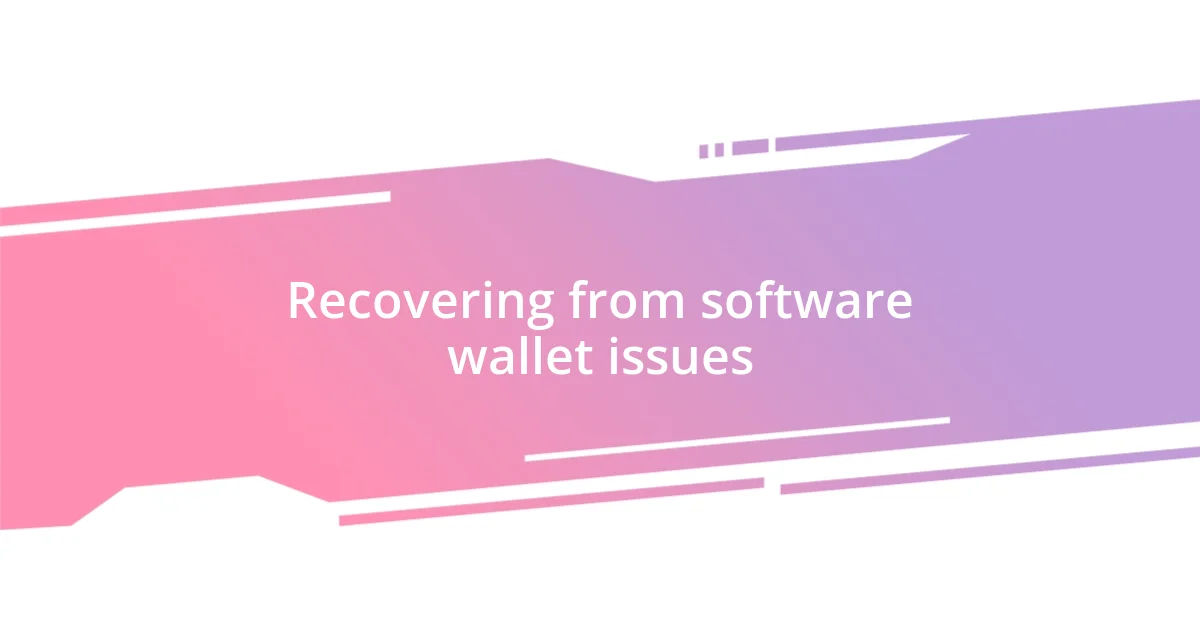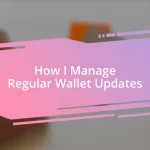Key takeaways:
- Software wallets are divided into hot wallets (online) and cold wallets (offline), with hot wallets offering convenience but higher security risks.
- Key factors when choosing a software wallet include security features, ease of use, and community feedback; prioritize wallets with strong reputations.
- Implement best practices for security, such as using strong passwords, enabling two-factor authentication, and regularly updating the wallet software.

Understanding software wallets
Software wallets are digital tools that allow users to store, send, and receive cryptocurrencies like Bitcoin and Ethereum. When I first started using one, I remember feeling a mix of excitement and nervousness. The idea of managing my own digital assets was thrilling, but it also made me wary—what if I lost access?
There are two main types of software wallets: hot wallets, which are connected to the internet, and cold wallets, which are offline. I personally prefer hot wallets for their convenience, but I’ve learned to take extra precautions because they can be more susceptible to hacking. Have you ever thought about how easily we sometimes compromise our security for the sake of ease?
One of the standout features of software wallets is their user-friendly interfaces. The first time I used one, I was surprised at how intuitive it felt; I could send crypto with just a few taps on my phone. It’s almost exhilarating, like having a bank in my pocket. But this ease of use can also lead to complacency, reminding me that we must balance convenience with caution.

Benefits of using software wallets
Using software wallets comes with a plethora of benefits that can enhance your overall cryptocurrency experience. For me, one of the most significant advantages has been the ease of access to my funds. I recall a time when I needed to make a quick transaction while out with friends; being able to pull out my phone and complete it in seconds felt incredibly empowering. The convenience of having everything at my fingertips cannot be overstated—it truly makes managing my digital assets more seamless.
Here are some notable benefits of using software wallets:
- User-Friendly Interfaces: Most software wallets are designed for simplicity, making it easy for anyone to navigate and perform transactions without a steep learning curve.
- Instant Transactions: Unlike traditional banking systems, sending or receiving crypto can happen almost instantly, which is particularly useful during time-sensitive situations.
- Accessibility: With software wallets, you can access your cryptocurrency from anywhere, anytime, as long as you have your phone or computer handy.
- Cost-Effectiveness: Many software wallets come with minimal fees or none at all, allowing me to save more of my funds for investment rather than on transaction costs.
- Integration with Apps: Some wallets offer compatibility with various financial apps, allowing me to manage my crypto alongside other financial tools seamlessly.

Choosing the right software wallet
Choosing the right software wallet can feel overwhelming with so many options available. From my experience, it’s essential to consider factors like security features, ease of use, and the specific cryptocurrencies supported. I once spent days researching various wallets, and it truly paid off when I found one that offered both a strong reputation and multi-currency support.
Another critical aspect I look for in a software wallet is performance. Some wallets lag during transactions, and I can’t stress how frustrating that can be when time is of the essence. I recall a moment when I was trying to make a purchase and the wallet froze momentarily. That added pressure is something I’d prefer to avoid.
Lastly, community feedback and expert reviews can provide valuable insights. I often check user reviews to ensure that the wallet has a positive track record. I remember reading a thread where users shared their experiences with a wallet that seemed promising but had a series of unresolved security issues. Someone’s bad experience can save others a lot of trouble in the long run.
| Wallet Feature | Example |
|---|---|
| Security Features | 2FA, Encryption, Backup Options |
| User Experience | Easy Navigation, Fast Transactions |
| Supported Cryptocurrencies | Bitcoin, Ethereum, Altcoins |

Best practices for wallet security
When it comes to wallet security, I always emphasize the importance of strong passwords. I remember the time I learned this lesson the hard way. One of my early wallets had a simple password, and after a friend pointed it out, I realized just how risky that was. Consequently, I switched to a complex, unique password that combines letters, numbers, and symbols. Trust me, it’s worth taking a bit of extra time to create a robust password; it’s like having a strong lock on your front door.
Another best practice I follow is enabling two-factor authentication (2FA) whenever possible. This added layer of security has saved my assets more times than I can count. I can’t recall how many attempts I avoided after being prompted for my 2FA code. Each time I receive that additional verification prompt, I breathe a sigh of relief, knowing I’ve taken another step to keep my wallet secure.
Regularly updating your software wallet is crucial too. I can’t express the peace of mind I feel knowing that I’m running the latest version, which often includes patches for any vulnerabilities. Once, I neglected an update for a couple of weeks, and I still can’t shake the unease I felt during that time. It’s like driving a car with a known defect—better to address issues before they lead to a breakdown. So, I make it a habit to check for updates regularly, ensuring that my funds stay protected.

Common software wallet risks
Software wallets, while convenient, have their fair share of risks that I’ve come to understand over time. One major risk is phishing attacks, where malicious parties impersonate legitimate services to trick users into revealing their private keys or passwords. I recall a time when I almost clicked on a link that seemed harmless but, thankfully, a gut feeling prompted me to double-check. That close call reminded me to always verify sources before entering sensitive information.
Another significant threat is software vulnerabilities. I’ve experienced the anxiety of realizing that a wallet I trusted had a flaw that could expose my funds. I once used a popular wallet and discovered, through community alerts, that it had a known exploit. It felt like a wake-up call, prompting me to urgently move my assets to a more secure option. Always stay informed about the security status of the wallets you use—this knowledge can be your best defense.
Lastly, the risk of device theft or loss cannot be overlooked. I remember a time when I left my phone unattended for just a moment at a café, and my heart raced thinking about the wallet app on it. While I was lucky that day, it left me with a lesson; utilizing recovery phrases and securing your devices is vital. How would you feel if you lost access to your digital assets in a split second? Being proactive about these security measures can help you avoid a potential nightmare scenario.

Recovering from software wallet issues
Recovering from software wallet issues often feels daunting, but I’ve learned that the first step is to stay calm and assess the situation. Once, I logged into my wallet only to find that my funds were missing. My heart raced, and I thought, “What now?” After gathering my thoughts, I revisited my transaction history. This helped me identify any unauthorized transactions—an essential step in tracing potential theft.
If you find yourself locked out of your wallet, don’t panic. A few months back, I accidentally reset my device, thinking I had backed everything up. I had nearly lost all access. Thankfully, I had my recovery phrase written down safely. This experience underscored the importance of keeping such phrases secure and accessible. Always ensure you have a backup plan; it’s like insurance for your digital assets.
Another vital aspect is reaching out to wallet support teams as soon as you encounter issues. I remember when a major glitch in my wallet’s interface left me unsure of my balance. Contacting customer support was intimidating; I expected long waits and vague responses. To my surprise, I received informative advice within hours, guiding me on the necessary steps to regain access to my funds. Trust me—sometimes, a little help goes a long way in resolving wallet troubles.














